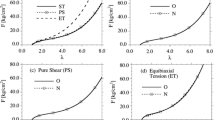Abstract
The condition of ellipticity of the equilibrium equation plays an important role for the correct description of the mechanical behavior of materials and is a necessary condition for new constitutive relations. Earlier, new deformation measures were proposed to remove correlations between the terms, which dramatically simplifies restoration of constitutive relations from experimental data. One of these new deformation measures is based on the QR-expansion of deformation gradient. In this paper, we study the strong ellipticity condition for hyperelastic material using the QR-expansion of deformation gradient.
Similar content being viewed by others
References
P. Ciarlet, Mathematical Elasticity [Russian translation], Mir, Moscow (1992).
J. C. Criscione, “Rivlin’s representation formula is ill-conceived for the determination of response functions via biaxial testing,” In: The Rational Spirit in Modern Continuum Mechanics, Springer, Dordrecht (2004), pp. 197–215.
J. C. Criscione, J. D. Humphrey, A. S. Douglas, and W. C. Hunter, “An invariant basis for natural strain which yields orthogonal stress response terms in isotropic hyperelasticity,” J. Mech. Phys. Solids, 48, No. 12, 2445–2465 (2000).
J. C. Criscione, A. D. McCulloch, and W. C. Hunter, “Constitutive framework optimized for myocardium and other high-strain, laminar materials with one fiber family,” J. Mech. Phys. Solids, 50, No. 8, 1681–1702 (2002).
J. C. Criscione, M. S. Sacks, and W. C. Hunter, “Experimentally tractable, pseudo-elastic constitutive law for biomembranes: I. Theory,” J. Biomech. Eng., 125, No. 1, 94–99 (2003).
J. C. Criscione, M. S. Sacks, and W. C. Hunter, “Experimentally tractable, pseudo-elastic constitutive law for biomembranes: II. Application,” J. Biomech. Eng., 125, No. 1, 100–105 (2003).
A. D. Freed and A. R. Srinivasa, “Logarithmic strain and its material derivative for a QR decomposition of the deformation gradient,” Acta Mech., 226, No. 8, 2645–2670 (2015).
M. Hayes, “Static implications of the strong-ellipticity condition,” Arch. Ration. Mech. Anal., 33, No. 3, 181–191 (1969).
G. A. Holzapfel, “Biomechanics of soft tissue,” Handb. Mater. Behav. Models, 3, No. 1, 1049–1063 (2001).
J. D. Humphrey, “Computer methods in membrane biomechanics,” Comput. Methods Biomech. Biomed. Eng., 1, No. 3, 171–210 (1998).
J. K. Knowles and E. Sternberg, “On the failure of ellipticity and the emergence of discontinuous deformation gradients in plane finite elastostatics,” J. Elasticity, 8, No. 4, 329–379 (1978).
A. A. Kotiya, Mechanical Characterisation and Structural Analysis of Normal and Remodeled Cardiovascular Soft Tissue, Doctoral Diss., Texas A&M University (2008).
A. I. Lurie, Nonlinear Theory of Elasticity [in Russian], Nauka, Moscow (1980).
P. Martins, R. M. Natal Jorge, and A. J. Ferreira, “A comparative study of several material models for prediction of hyperelastic properties: application to silicone-rubber and soft tissues,” Strain, 42, No. 3, 135–147 (2006).
J. Merodio and R. W. Ogden, “Instabilities and loss of ellipticity in fiber-reinforced compressible nonlinearly elastic solids under plane deformation,” Int. J. Solids Struct., 40, No. 18, 4707–4727 (2003).
R. S. Rivlin and D. W. Saunders, “Large elastic deformations of isotropic materials. VII. Experiments on the deformation of rubber,” Philos. Trans. R. Soc. Lond. Ser. A Math. Phys. Eng. Sci., 243, No. 865, 251–288 (1951).
T. Sendova and J. R. Walton, “On strong ellipticity for isotropic hyperelastic materials based upon logarithmic strain,” Int. J. Nonlinear Mech., 40, No. 2, 195–212 (2005).
A. R. Srinivasa, “On the use of the upper triangular (or QR) decomposition for developing constitutive equations for Green-elastic materials,” Int. J. Eng. Sci., 60, 1–12 (2012).
C. Truesdell, A First Course in Rational Continuum Mechanics. Vol. 1: General Concepts, Academic Press, New York–San Francisco–London (1977).
E. E. Tyrtyshnikov, Matrix Analysis and Linear Algebra [in Russian], Fizmatlit, Moscow (2007).
Author information
Authors and Affiliations
Corresponding author
Additional information
Translated from Sovremennaya Matematika. Fundamental’nye Napravleniya (Contemporary Mathematics. Fundamental Directions), Vol. 63, No. 3, Differential and Functional Differential Equations, 2017.
Rights and permissions
About this article
Cite this article
Salamatova, V.Y., Vasilevskii, Y.V. On Ellipticity of Hyperelastic Models Restored by Experimental Data. J Math Sci 253, 720–729 (2021). https://doi.org/10.1007/s10958-021-05264-y
Published:
Issue Date:
DOI: https://doi.org/10.1007/s10958-021-05264-y



